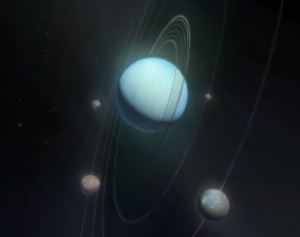Two of Uranus’ Moons may have active oceans: NASA study IANS Updated: March 21st, 2023, 18:40 IST in Sci-Tech 0 Pic- IANS Share on Facebook Share on Twitter Share on WhatsApp Share on Linkedin Washington: One or two of Uranus’ 27 moons — Ariel and/or Miranda — likely have oceans beneath their icy surfaces and are actively spewing material into the space environment, according to a study by NASA. Previously, Jupiter, Saturn, and Neptune were found as hosts to at least one icy moon that’s pumping particles into its planetary system. In the study led by the Johns Hopkins Applied Physics Laboratory (APL) in Maryland, US, researchers reanalysed nearly 40-year-old energetic particle and magnetic field data taken by NASA’s Voyager 2 spacecraft — the only spacecraft so far to have gone to Uranus.
They found a trapped population of energetic particles the spacecraft had observed while departing Uranus — the turquoise, tilted oddball of the solar system. “What was interesting was that these particles were so extremely confined near Uranus’ magnetic equator,” said lead author Ian Cohen, a space scientist at APL. Magnetic waves within the system would normally cause them to spread out in latitude, he explained, but these particles were all cramped near the equator between the moons Ariel and Miranda.
Scientists originally attributed these features to Voyager 2’s possibly having flown through a chance stream of plasma being “injected” from the distant tail of the planet’s magnetosphere. But that explanation doesn’t hold, Cohen said. “An injection would normally have a much broader spread of particles than what was observed.
” The team suspects the particles arise from Ariel and/or Miranda through either a vapour plume similar to that seen on Enceladus or through sputtering — a process where high-energy particles hit a surface, ejecting other particles into space. Yet scientists have already suspected Uranus’ five largest moons — Ariel and Miranda included — may have subsurface oceans. Voyager 2 images of both moons show physical signs of geologic resurfacing, including possible eruptions of water that froze on the surface.
“The data are consistent with the very exciting potential of there being an active ocean moon there,” Cohen said. “We can always do more comprehensive modeling, but until we have new data, the conclusion will always be limited. ” The findings, recently accepted for publication in the journal Geophysical Research Letters, were also presented at the annual Lunar and Planetary Science Conference in the US.
IANS Tags: Moon NASA study Ocean solar system Uranus water Share Tweet Send Share Suggest A Correction Enter your email to get our daily news in your inbox. Leave this field empty if you’re human: Related Posts Cybercrime likely to rise as Google, Microsoft mull adding AI to office suites March 21, 2023 Amazon deepens tech gloom as 503 firms lay off 1. 5 lakh employees March 21, 2023 Odisha: Jio launches 5G services in Byasanagar, Rayagada March 21, 2023 ChatGPT suffers mega outage, chat history unavailable for most users March 21, 2023 Accenture to acquire Bengaluru-based industrial AI firm Flutura March 21, 2023 Google giving some Pixel Superfans chance to try Bard AI March 21, 2023 Leave a Reply Cancel reply Your email address will not be published.
Required fields are marked * Comment * Name * Email * Website Save my name, email, and website in this browser for the next time I comment. Δ.
From: orissapost
URL: https://www.orissapost.com/two-of-uranus-moons-may-have-active-oceans-nasa-study/



